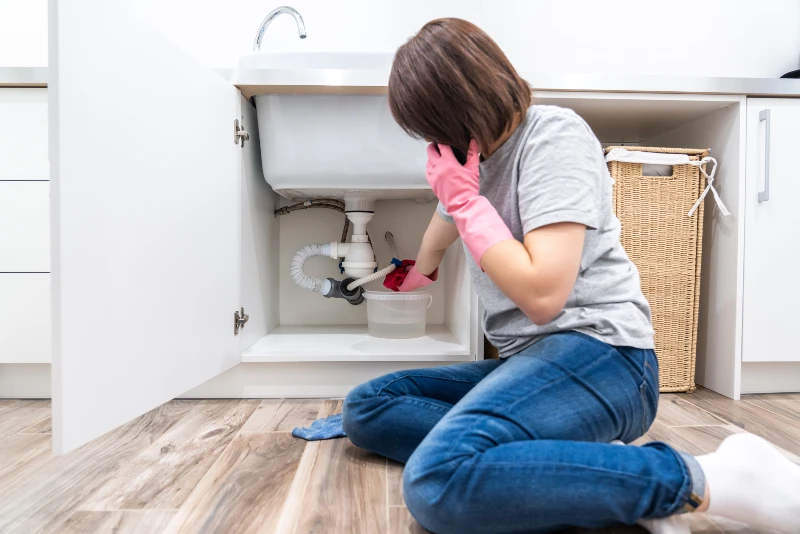Finding where the kitchen sink is leaking is the first step to fix the problem. As you know, the method to fix the leak depends on where it is coming from.
If you’re experiencing a leaky kitchen sink, rest assured that you’re not alone. This common household issue can cause frustration and even costly water damage if not addressed.
Here are common 9 reasons your kitchen sink might be leaking and how you can fix it. Understanding why each of these problems causes leaks and what you can do about them will help you keep your kitchen in top shape.
1. Valve Seat Corrosion
The valve seat acts as the intermediary between the faucet and the spout, controlling the flow of water when the tap is turned off.
However, over time, minerals in your water can deposit on the valve seat, leading to corrosion. This corrosion can create gaps between the valve seat and the spout, which can cause leaks.
Why It Causes Leaks
Water with a high mineral content often causes more wear on the valve seat. When minerals build up, they can corrode the valve seat, resulting in a breach that allows water to leak out.
How to Fix
You will need to remove the spout and use a valve seat wrench to take out the corroded valve seat. Once it is removed, you can replace it with a new one. Applying a layer of plumber’s grease can also help prevent future corrosion.
2. Loose Water Supply Connection
Your sink’s water supply comes via lines that are often secured with compression fittings. These lines can sometimes become loose, either due to a faulty installation or because natural movement and shifting occur in your plumbing over time.
Keep in mind that these supply connections also bear the brunt of changes in water pressure.
Why It Causes Leaks
Loose connections mean that the seal which keeps water from escaping is compromised. Each time the tap is turned on, water pressure can force a leak at this weak point.
How to Fix
Firstly, turn off the water supply. Then, use a wrench to check the connections. Tighten them to ensure they are snug, but be careful not to over-tighten as this can damage the connections. If the leak continues, you might need to replace the supply lines altogether.
3. Damaged O-Ring
The O-ring is a small, typically rubber ring that seals the joint between two parts of your faucet. The constant use of the faucet handle can eventually lead to wear and tear on the O-ring, compromising its ability to stop water from leaking out around the handle.
Why It Causes Leaks
When the O-ring is damaged or worn out, it cannot create a watertight seal, thereby allowing water to escape through newly formed gaps when the faucet is turned on. Sometimes, the O-ring can also become dislodged.
How to Fix
To replace the O-ring, shut off the water supply and remove the faucet handle to access the O-ring. Note the size and diameter of the existing O-ring to purchase the correct replacement.
Apply plumber’s grease to the new O-ring and fit it securely into position, then reassemble the faucet. This should resolve any leaks if the O-ring was indeed the problem.
4. Clogged P-Trap
The P-trap’s purpose extends beyond trapping debris; it also prevents sewer gases from rising up through the pipes.
However, accumulation of debris such as food particles, grease, and soap can lead to clogs. A clogged P-trap increases pressure within the pipe, which can cause leaks at weak points or connections.
Why It Causes Leaks
When a P-trap is clogged, water starts to back up, increasing the pressure within the pipe. This amplified pressure can exploit any minor weakness or loose connection, resulting in a leak.
How to Fix
Place a bucket under the P-trap to catch any spillage, then unscrew the P-trap from the piping beneath the sink. Clear out the debris manually or by using a plumbing snake.
Before reattaching the P-trap, inspect for signs of damage and, if necessary, replace it. Use plumber’s tape to reinforce the threads for a secure fit.
5. A Corroded P-Trap
The constant presence of water, cleaning products, and waste materials can lead to the corrosion of metal P-traps over time. Acidic substances or cleaners can accelerate this corrosion, potentially causing holes to form in the pipe where water can leak out.
Why It Causes Leaks
Corrosion weakens the structural integrity of the P-trap, eventually leading to small perforations or cracks through which water can seep out.
How to Fix
If the P-trap is made of metal and shows signs of corrosion, it’s typically best to replace it altogether. PVC P-traps have a longer lifespan when it comes to corrosion resistance.
When installing a new P-trap, ensure that all connections are secure, and consider using PVC pipes for increased durability.
6. Faulty Faucet
A faucet is made up of several components, including valves, washers, and gaskets. With time and usage, these parts can wear out or break, leading to water leaks. In some cases, the problem might be with the faucet’s cartridge, which controls the flow and temperature of water, or with the aerator, which can become clogged.
Why It Causes Leaks
A faulty faucet can drip continuously or leak at the base, depending on which part is failing. A worn-out washer or a broken seal can allow water to seep through. If the cartridge is damaged, it can cause improper water flow and lead to leakage.
How to Fix
Start by identifying the type of faucet you have (compression, ball, disk, or cartridge) because the repair process differs for each type. For washer-based faucets, replacing the washer will often resolve the leak. If the faucet has a cartridge, you may need to replace the entire cartridge.
For aerator issues, unscrew the aerator, clean it, and screw it back on. If parts are corroded or extensively worn, it’s usually best to replace the entire faucet to prevent future leaks.
7. Drain Leak
The sink drain may develop leaks due to a faulty washer or through the breakdown of plumber’s putty that seals the drain flange to the sink basin. A visible sign of a drain leak would be water pooling in the cabinet underneath the sink or moisture around the drain area itself.
Why It Causes Leaks
Leaking at the drain is typically due to a breach in the seal that holds the drain assembly tight against the sink bottom. Normal wear and tear or improper installation can cause this seal to fail.
How to Fix
First, tighten the locknut holding the drain in place to see if this stops the leak. If it persists, you’ll need to disassemble the drain to apply new plumber’s putty or to replace any faulty gaskets or washers. Ensure all parts are reassembled tightly to maintain the integrity of the seal.
8. A Worn Washer
Faucet washers endure the pressure and friction of the valve seat each time the faucet is used, which can lead to wear and cause drips. A worn washer is one of the most common causes of faucet leaks.
This type of leakage typically presents itself as a drip that’s consistent and often becomes more pronounced when the tap is turned off.
Why It Causes Leaks
A washer that has lost its structural integrity cannot form a proper seal, allowing water to trickle through even when the faucet is turned off. Over time, the friction between the washer and the valve seat can degrade the washer, leading to leaks that emerge from the spout.
How to Fix
Shut off the water supply to the sink before you start working. Take apart the faucet assembly to access the washer. Inspect the valve seat as well—if it’s damaged, it may also need resurfacing or replacement. Replace the old washer with a new one that matches in size and shape.
It’s a good practice to also coat the new washer with plumber’s grease before installing it. Reassemble the faucet and open the water supply to test.
9. High Water Pressure
While not directly related to the structural integrity of sink components, high water pressure can contribute to leaks.
Excessively high pressure can place undue stress on your plumbing system and can result in leaks at various points, including the kitchen sink. This can manifest as nighttime leaking or leaks that occur when multiple fixtures are in use.
Why It Causes Leaks
Normal residential water systems are designed for a certain range of pressure, typically between 40 and 60 psi. When the pressure exceeds this range, it can cause leaks at weak points such as valve seals or pipe junctions.
High pressure can also accelerate the wear of various plumbing components, leading to more frequent and diverse leaks.
How to Fix
You might need to install a pressure regulator to lower the water pressure in your plumbing to an acceptable level. You can test your water pressure with a gauge that attaches to an outdoor spigot.
If adjustments to your current regulator don’t fix the problem or if you don’t have a regulator installed, you may want to consult a plumber.
Conclusion
Leaks in your kitchen sink can arise from a variety of sources, from worn-out washers and O-rings to high water pressure and corroded plumbing. While some fixes are relatively simple and can be undertaken as DIY projects, others might require the expertise of a professional plumber.
Regular preventative maintenance and careful use of your sink and its components will help extend the life of your plumbing and prevent many common leaks.




